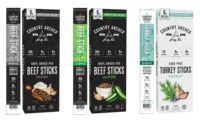On the Mark
By Andy Hanacek, executive editor
More than 20 years after the launch of its meat and deli department, Costco Wholesale continues to meet the needs of its customers above all else.
The first time someone walks into a Costco warehouse, they often respond with the look of a kid who just walked into a candy store toting a $100 bill, free of parental supervision. Even decades after the launch of the idea that consumers could buy in bulk at ultra-low prices, there are still consumers who are realizing this experience even today.
Costco Wholesale Inc. has found success in offering high-quality items across the retailing spectrum, from DVDs and 52-inch plasma TVs to brand name clothing and dishwashing detergent on down the line to food, drug and perishable items. More than 20 years ago, Costco launched its first meat department, applying the same principles and strategies that carried its entire business to that area of the marketplace, and the results have been astounding.
Not only has Costco found success in its apparel, electronics and household items departments (to the tune of $1.9 billion worth of TVs sold in fiscal year 2007 as a prime example), but the warehouse club’s meat, poultry, seafood and deli departments have grown tremendously in just more than two decades.
For fiscal year 2007, seafood sales at Costco were $550 million, according to the company’s Web site. The retailer sells 34.7 million rotisserie chickens annually, totaling $173 million, lending credence to a saying relayed through the ranks from Jim Sinegal, president and CEO of Costco, that “it’s just not safe to be a chicken around here.”
Additionally, Costco sold 69.3 million hot dog and soda combos through its in-store foodservice stands in 2007.
Suffice to say, the marriage between the meat and poultry industries and Costco has been a consumer-friendly perfect match. But Costco, on its own, continues to be quite the success story as well.
In early March, Bloomberg News reported that Costco’s second-quarter profit rose 31 percent as shoppers stocked up on food to make fewer trips to other stores, citing rising fuel costs as a reason for this consumer trend. Net income climbed to $327.9 million, or 74 cents a share, matching the Issaquah, Wash.-based company’s previous outlook. Furthermore, revenue advanced 12 percent to $16.6 billion.
Aside from the previously mentioned TV sales, some of the other outstanding numbers Costco posted during fiscal 2007 include:
• $867 million total U.S. wine sales
• 27.9 million prescriptions filled
• 2.4 million pairs of eyeglasses sold
• 86 percent membership renewal rate
• 31 new warehouses opened
• $867 million total U.S. wine sales
• 27.9 million prescriptions filled
• 2.4 million pairs of eyeglasses sold
• 86 percent membership renewal rate
• 31 new warehouses opened
What’s the secret? Well, it’s a combination of things. First, Costco truly lives by the adage that the customer is always right. Product stock-keeping units (SKUs) are kept under control and focused sharply upon customer desires. Costco treats its employees very well, paying them and insuring them quite well — to the degree that stockholders have been known to complain to executives about the compensation and salary packages from time to time. Furthermore, Costco strives to employ fantastic people in its stores.
Finally, and probably most important, is Costco’s ability to portray a quality image. Customers know that they’re not only getting the best value from a retailer striving to be the “absolute pricing authority,” but when a member walks in the door to make a purchase, Costco wants that customer to leave (and he or she nearly always does) knowing that they got a high-quality item for their hard-earned dollar.
Its strategy and concern about its consumers also has helped it weather a bit of a storm in terms of a recent product recall. In March, Costco recalled about 10,000 pounds of frozen chicken entrees because of the possibility of Listeria contamination. In a statement to the Salt Lake Tribune, Bob McColl, with Inovata Foods of Alberta, Canada, maker of the recalled product, explained that Costco was able to mail alert letters to each member who purchased the product, letting them know to return the packages for a refund.
Because Costco doesn’t carry nearly as many stock-keeping units as a typical retailer might carry, something like this is much easier to track and resolve.
Meanwhile, aside from carrying bulk products at prices that attract consumers, Costco has done an excellent job developing the aura that it sells high-quality, upscale product for a more refined audience. In the meat and poultry department, it is no different. To that end, Charlie Winters, who is considered the pioneer of Costco’s meat department, explained in Farm to Plate magazine that Costco’s deep-seated connection with its customers is what helps drive the strategy.
Once Costco knows what its customers want, it can approach its supplier and work with that supplier to ramp up the quality of the product, he says, whether they’re talking about bulk ground beef, rotisserie chickens or pork tenderloin.
Warehouses typically stock about 65 varieties of fresh meat and poultry, and it uses unsold but still very fresh rotisserie chickens for its 32 or so deli items, including Rotiserrie Chicken Caesar Salad, among others.
Costco is willing to look beyond simply modifying its SKU count to improve items for its customers as well. For example, Costco eliminated Styrofoam trays from meat packaging and also began using saddle-pack packaging for many of its meat items, including Foster Farms frozen (and marinated) chicken breasts. These are portioned and convenient for the customers, as the six-pack can easily be divided by meal and the remainder frozen for future use.
The retailer employs several butchers per warehouse, and ground beef is produced at the company’s grinding facility in Tracy, Calif. That plant pumps out about 70,000 pounds of ground beef and meatballs per hour. E. coli testing occurs at the plant and at the warehouses, as food safety is clearly a top-tier issue for Costco.
Costco at a glance
Warehouses (as of December 2007):
529
Warehouse Locations:
389 locations in 40 U.S. states and Puerto Rico
75 in Canada
30 in Mexico
19 in the United Kingdom
6 in Japan
5 in Korea
5 in Taiwan
Annual sales:
$63.1 billion (fiscal year 2007)
Average sales/warehouse:
$130 million
Worldwide employees:
136,000 full- and part-time
Transactions per day:
1.3 million
529
Warehouse Locations:
389 locations in 40 U.S. states and Puerto Rico
75 in Canada
30 in Mexico
19 in the United Kingdom
6 in Japan
5 in Korea
5 in Taiwan
Annual sales:
$63.1 billion (fiscal year 2007)
Average sales/warehouse:
$130 million
Worldwide employees:
136,000 full- and part-time
Transactions per day:
1.3 million
Membership (as of December 2007):
51.0 million cardholders
27.8 million households
Source: “Costco Today” presentation; Costco Wholesale Inc.
51.0 million cardholders
27.8 million households
Source: “Costco Today” presentation; Costco Wholesale Inc.
Costco’s recent recognition
• 2007 Meat & Deli Retailer of the Year, Meat & Deli Retailer magazine, October/November 2007.
• 4th largest retailer in the U.S., Retailing Today, June 2007.
• 8th largest retailer in the world, Stores Magazine, January 2007.
• Ranked 32nd in Fortune 500, Fortune magazine, April 2007.
• 4th largest retailer in the U.S., Retailing Today, June 2007.
• 8th largest retailer in the world, Stores Magazine, January 2007.
• Ranked 32nd in Fortune 500, Fortune magazine, April 2007.
Excerpt from Meat & Deli Retailer’s Retailer of the Year story on Costco, as it appeared in the October/November 2007 issue:
Jeff Lyons, senior vice president and general merchandise manager, fresh foods, attributes much of Costco’s fortune to the talents of its employees and the culture of the company.
“The real trick is having good people and working for an organization that gives you the freedom and flexibility to be creative, and doesn’t crush you if you are not totally successful initially,” he notes. “It is important to have a company that sees the long-term benefits. Our success is always people, always being creative, always having more ideas and never being frustrated.”
Such ideas, for instance, result in the frequent merchandising of new prepared food recipes in the deli case and internal cost-cutting initiatives that help forestall price increases.
“We’re always looking at how we can be more productive, which drives the payroll down,” notes Alan Bubitz, vice president and general merchandise manager, fresh foods and foodservice. “To offset higher food expenses we try to focus on the things that we can control, such as improving food quality and increasing sales by replacing lower-selling items.”
In recognition of it success in meeting consumers’ demands for quality and affordable proteins by leveraging a novel and narrow business model, Costco is Meat & Deli Retailer’s 2007 Retailer of the Year.
What others have said...
“In perishables, meat and fish are the two that get talked about all the time. In some respects, they are the gold standards in the industry as a whole. There is a powerful reason why people pick Costco — they are very high volume and their sales speak for themselves.”
— Michael Sansolo, supermarket industry consultant; Farm to Plate, August 2007.
“Costco experiments quite a bit more than its competition and has a lot more unique offerings in the meat and deli areas. Their attention to quality is enhanced by having a limited number of SKUs. They have a niche and don’t try to meet all shoppers’ needs. It is a philosophy that they carry out incredibly well.”
— Ben Ball, senior vice president of Dechert-Hampe & Co.; Meat & Deli Retailer, October/November 2007.
“Costco doesn’t sell anything that doesn’t have an incredibly high turn. ... Because it turns so frequently, the opportunity for the meat to stay fresh is very good.”
— Mark Boyer, president of PMG LLC; Farm to Plate, August 2007.

